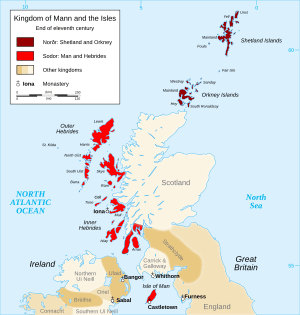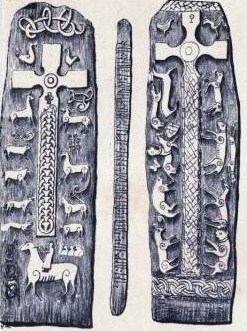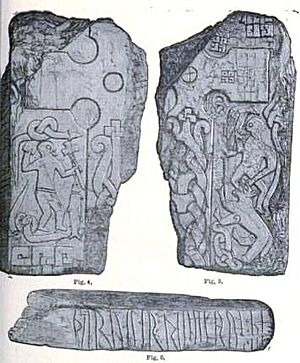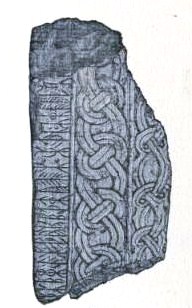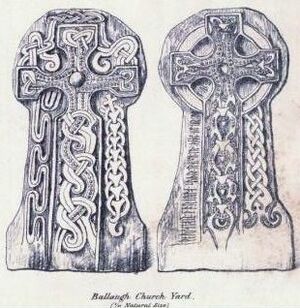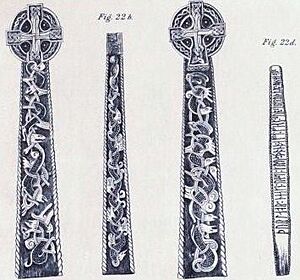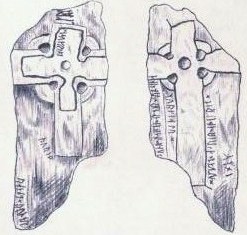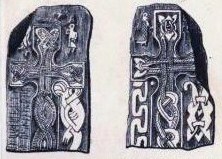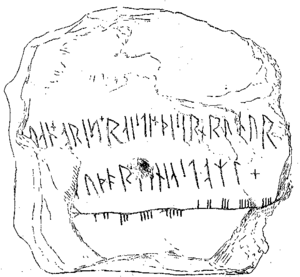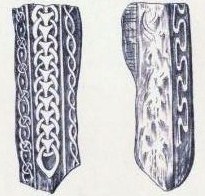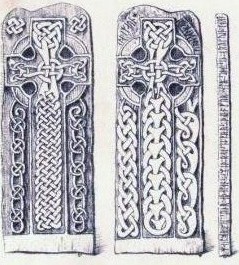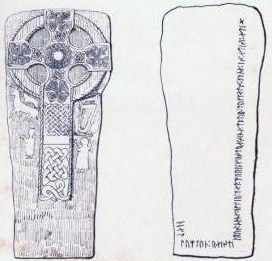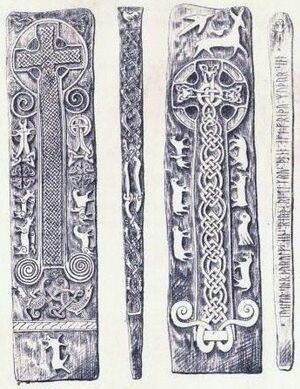Manx runestones facts for kids
The Manx runestones are special stone monuments made by the Vikings who lived on the Isle of Man. Most of these stones were carved during the Viking Age, especially in the 900s. Even though the Isle of Man is small, it has many Viking Age runestones. In fact, in 1983, there were 26 known stones, which is almost as many as in all of Norway (33 stones)!
One reason there are so many runestones on the Isle of Man is that the Vikings mixed their tradition of making runestones with the local Celtic tradition of putting up tall high crosses. The church also helped by not saying runes were bad or "pagan." Instead, they encouraged people to record names and messages for Christian reasons. Many of these stones have a common message like, "N... put up this cross in memory of M." Some stones were even put up by the person who carved them!
Manx runestones are similar to those found in Scandinavia. However, in Norway, a runestone is called a "stone," even if it looks like a cross. But on the Isle of Man and other British Isles, these monuments are usually called "crosses." There are also two flat stones in Maughold with Anglo-Saxon runes carved into them.
Contents
- Discovering Manx Runestones
- Andreas Parish: Stones with Stories
- Ballaugh Parish: Remembering Family
- Braddan Parish: A Collection of Stones
- Bride Parish: A Wife Remembered
- Onchan Parish: Many Messages
- German Parish: Chapel Crosses
- Jurby Parish: A God's Horn?
- Marown Parish: Viking Age Inscription
- Maughold Parish: Runes and Ogham
- Michael Parish: Many Crosses
- Images for kids
Discovering Manx Runestones
Andreas Parish: Stones with Stories
Br Olsen;183 (Andreas I)
This runestone is a stone cross found in the Andreas church. Its message is written in short-twig runes and remembers a father.
Br Olsen;184 (Andreas II)
You can find this stone cross in the Andreas church. It has short-twig runes and was made around the year 940. It was put up to remember a wife.
Thorwald's Cross: Br Olsen;185A (Andreas III)
This famous stone cross, known as Thorwald's Cross, is in Andreas church. Only the name of the person who put it up, Þorvaldr, can still be read. The stone has been damaged over time.
It shows a bearded person holding a spear, pointing it down at a wolf. The wolf has the person's right foot in its mouth. A large bird sits on the person's shoulder. Some experts think this carving shows the Norse god Odin with his raven or eagle. They believe it shows Odin being eaten by the wolf Fenrir during the end-of-the-world event called Ragnarök.
Next to this image, there is a large cross and another picture that might show Christ winning over Satan. Because it mixes old Norse beliefs with Christian ideas, this cross is called "syncretic art."
Br Olsen;185B (Andreas IV)
This stone cross is also in the Andreas church. It has short-twig runes and was made in the 900s. The message tells us it was put up to remember someone.
Br Olsen;185C (Andreas V)
Only small pieces of this stone cross are left, and they are in the Andreas church. The message on it is hard to read because it uses unusual twig runes and bind runes (where two runes are joined together).
Ballaugh Parish: Remembering Family
Br Olsen;189 (Ballaugh)
This stone cross is located in Ballaugh. It has short-twig runes from the second half of the 900s. It was put up to remember a son.
Braddan Parish: A Collection of Stones
Br Olsen;190B (Braddan I)
This stone cross is in the Braddan church. It has short-twig runes and was made between 930 and 950. It was put up to remember a man.
Br Olsen;191A (Braddan II)
You can find this stone cross in the Braddan church. It has short-twig runes from the second half of the 900s. The inscription on it talks about betrayal.
Br Olsen;191B (Braddan III)
This stone cross is also in the Braddan church. It has short-twig runes from the 980s. We know that a runemaster named Thorbjörn made it. He also made another stone, Br Olsen;193A, which is mentioned below. This stone has been badly damaged since it was first recorded.
Br Olsen;193A (Braddan IV)
This runestone is from the 980s and is in the Braddan church. It has short-twig runes and was also made by the runemaster Thorbjörn, just like Br Olsen;191B. This stone was made to remember a son.
Bride Parish: A Wife Remembered
Br Olsen;193B (Bride)
This stone cross is in the Bride church. It has short-twig runes and was made between 930 and 950. It was put up to remember a wife.
Onchan Parish: Many Messages
Br Olsen;194 (Onchan)
This runestone has short-twig runes carved onto an old Irish stone cross. Some of the carvings are from the Viking Age, while others were added later. Different people carved the different messages on this stone.
German Parish: Chapel Crosses
Br Olsen;199 (German I)
This stone cross is in the chapel of Saint John. It has short-twig runes from between 930 and 950. The carving is not very clear, and only a few main parts of the runes can be seen.
Br Olsen;200A (German II)
This stone cross is in the Manx Museum. It has short-twig runes, but they might be from a time after the Viking Age. It was carved to remember a wife.
Jurby Parish: A God's Horn?
Br Olsen;200B (Jurby)
This stone cross is in Jurby. Its short-twig runes are from the second half of the 900s. It has been damaged over time. One of the figures carved on the cross holds a small sword in one hand and an Alpine horn in the other. A raven flies above. Some people think this figure might be the Norse god Heimdall, holding his horn, the Gjallarhorn, which he would blow to announce Ragnarök.
Marown Parish: Viking Age Inscription
Br Olsen;201 (Marown)
This stone cross is in Saint Trinian's chapel. Its short-twig inscription is from the Viking Age.
Maughold Parish: Runes and Ogham
Br Olsen;202A (Maughold I)
This runic carving is on a stone slab that was used for a grave. It is near the Maughold church. The carving is from the second half of the 1100s, and the same person made it as Br Olsen;202B. You can also see the first part of the Ogham alphabet (an ancient Irish writing system) on this stone.
Br Olsen;202B (Maughold II)
This carving is on another stone slab that was used for a grave. It was found in the Corna valley but is now at the Maughold church. The short-twig carving is from the second half of the 1100s, and the same person made it as Br Olsen;202A.
Br Olsen;205B (Maughold IV)
This carving is from around the year 1000 and is on a stone slab used for a grave. It is at the Maughold church. The carving uses long-branch runes, except for one rune. People think a visitor to the Isle of Man might have made it.
Br Page1998;21 (Maughold V)
This carving is on a stone slab that was used for a grave. It is in the Manx Museum. It has short-twig runes from the Viking Age and was carved to remember a wife.
Michael Parish: Many Crosses
Br Olsen;208A (Kirk Michael I)
This piece of a stone cross is in the Kirk Michael church. The short-twig runes on it are from the Viking Age.
Br Olsen;208B (Kirk Michael II)
This stone cross is in the Kirk Michael church and is from the Viking Age. The short-twig runes were carved to honor a man while he was still alive.
Br Olsen;215 (Kirk Michael III)
This is an old Irish stone cross that later had long-branch runes carved on it. A Danish visitor probably made these carvings in the 1000s. It also has ogham carvings on both sides.
Br Olsen;217A (Kirk Michael IV)
This stone cross is in the Michael church. The short-twig runes on it were made in the second half of the 1000s.
Br Olsen;217B (Kirk Michael V)
This stone cross is in the Michael church. The short-twig runes were made in the 980s by a runemaster named Thorbjörn.
Br Olsen;218A (Kirk Michael VI)
This stone cross is in the Michael church. It was carved with short-twig runes in the second half of the 900s.
Images for kids


